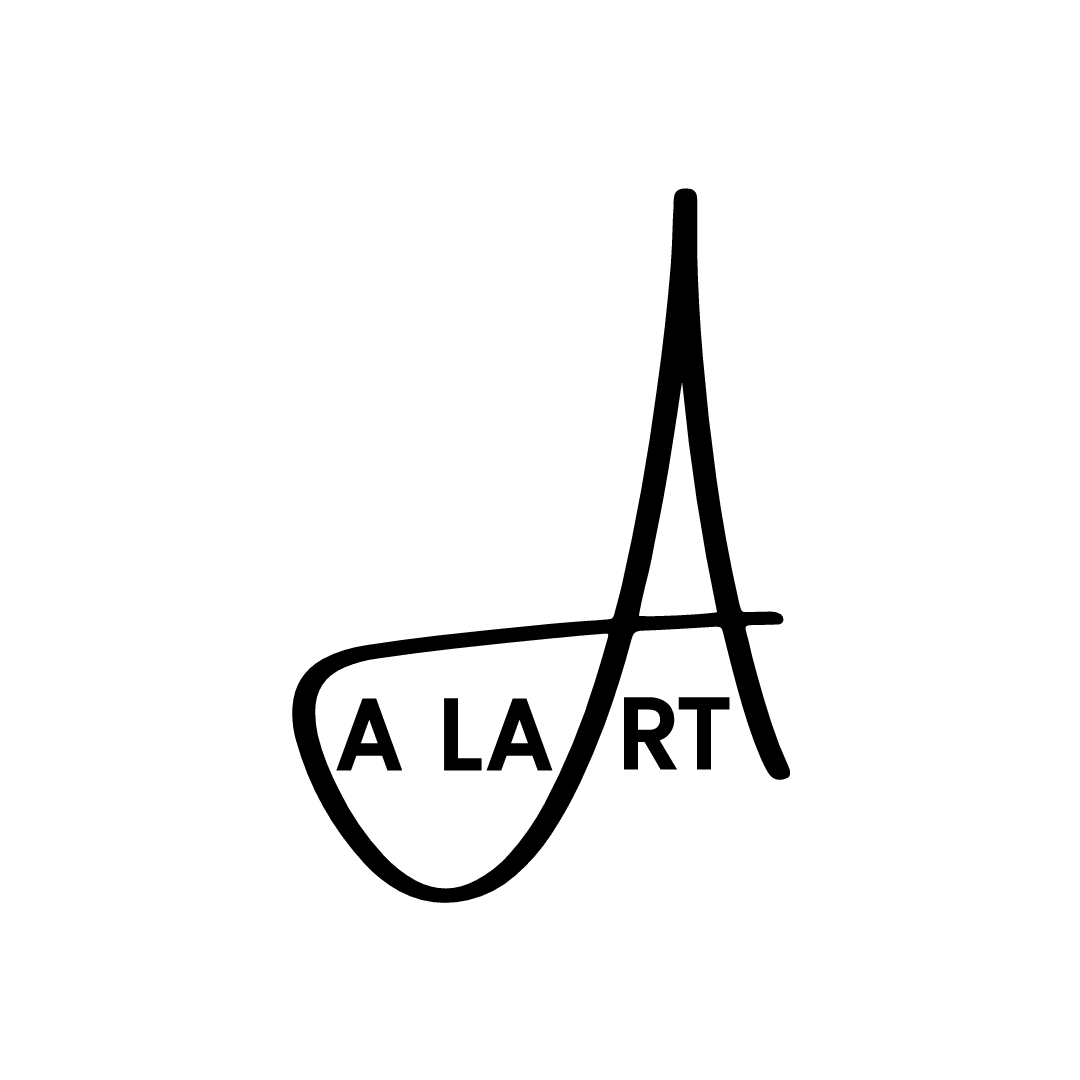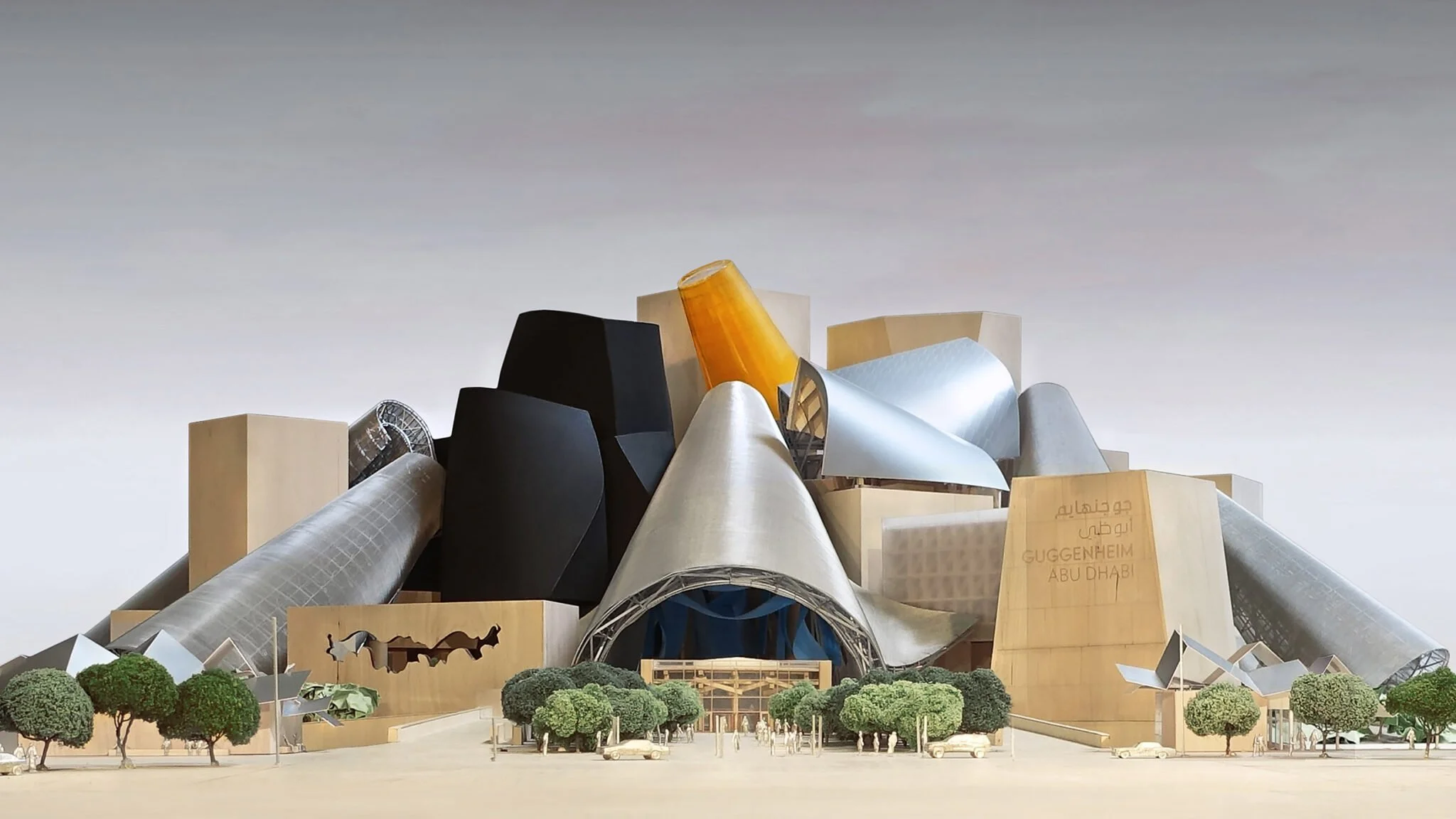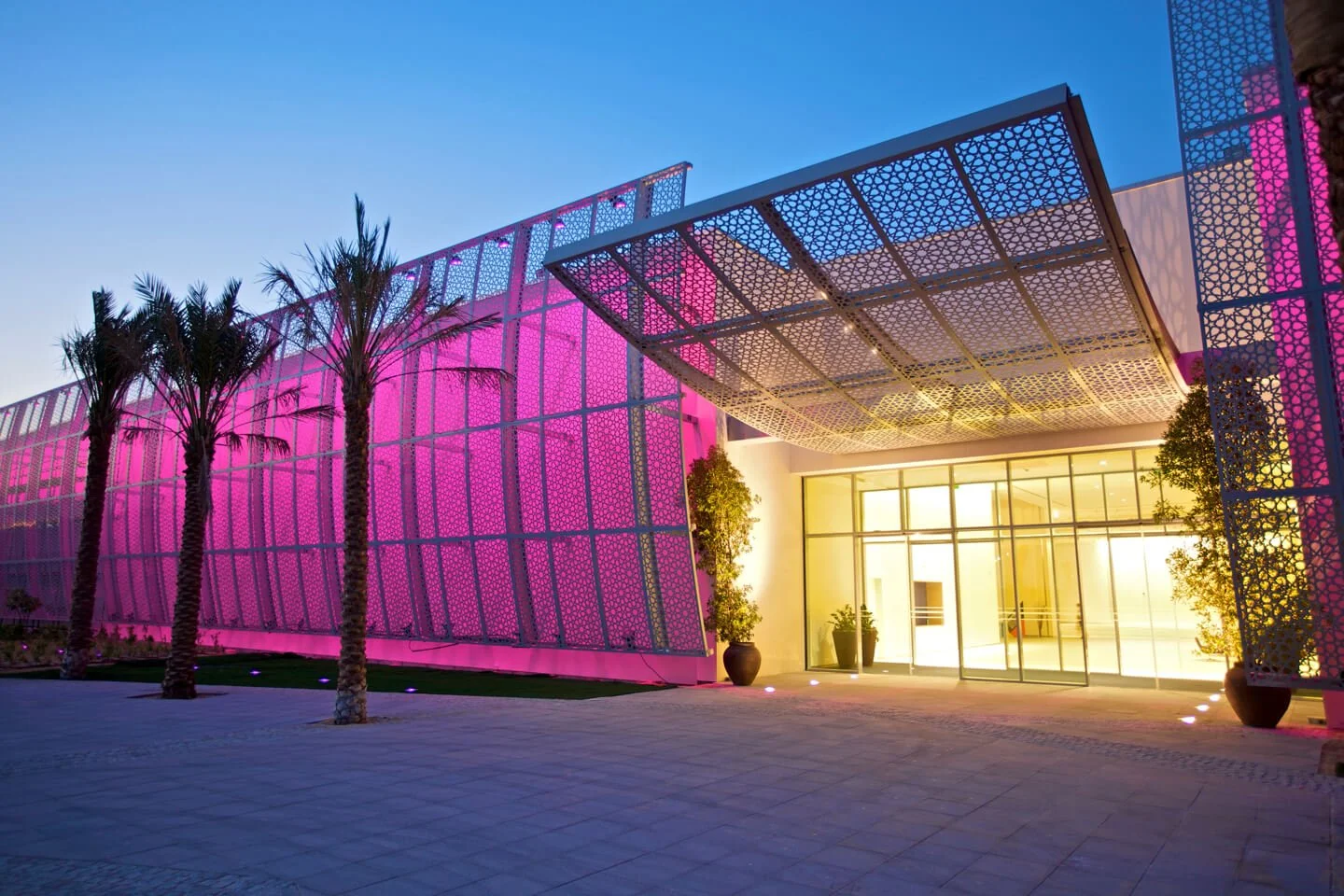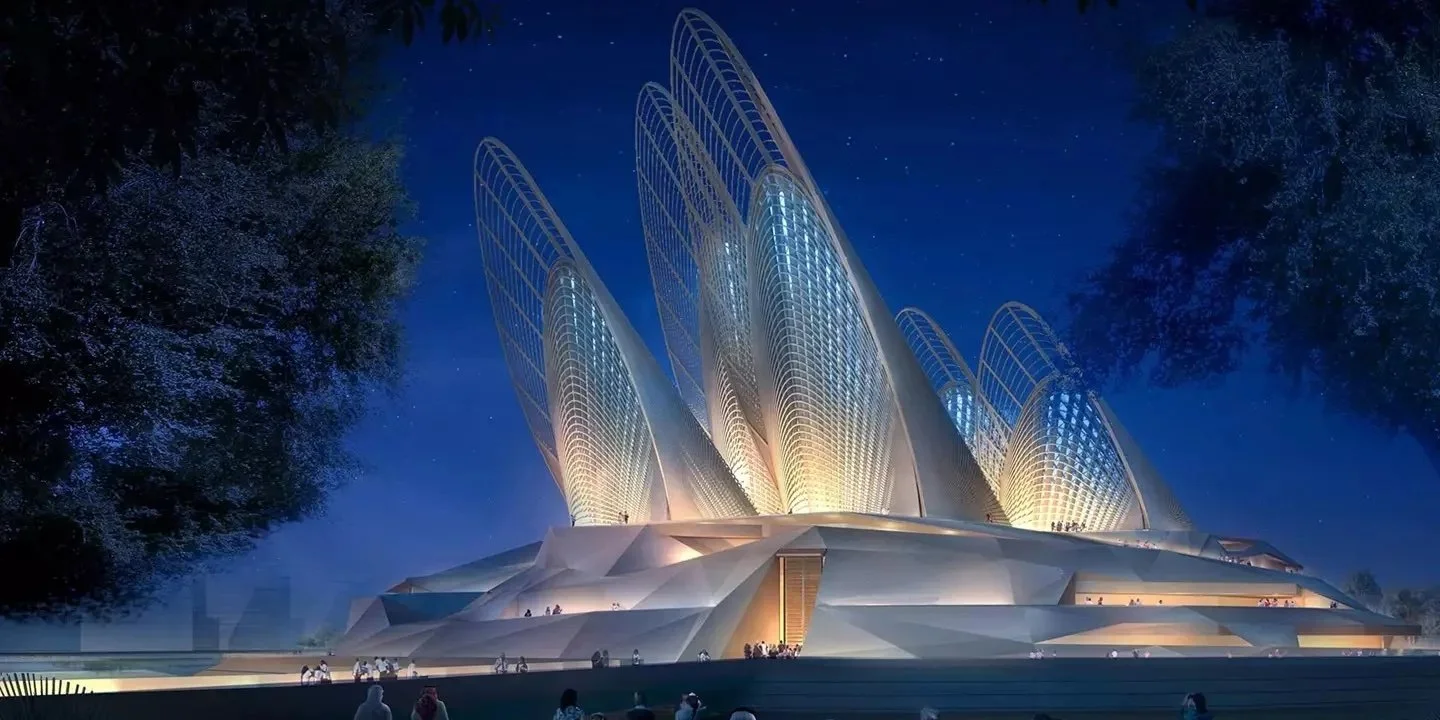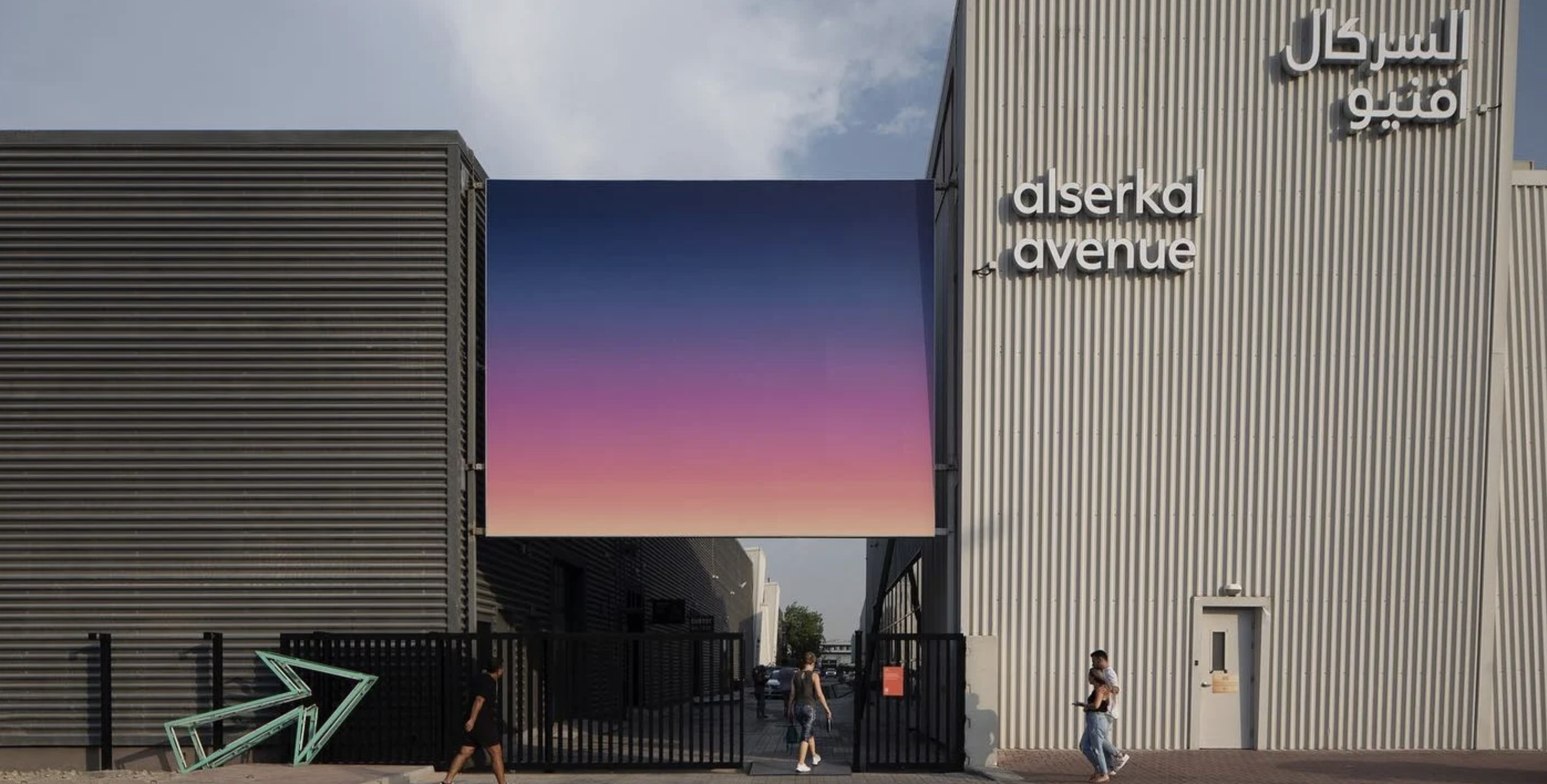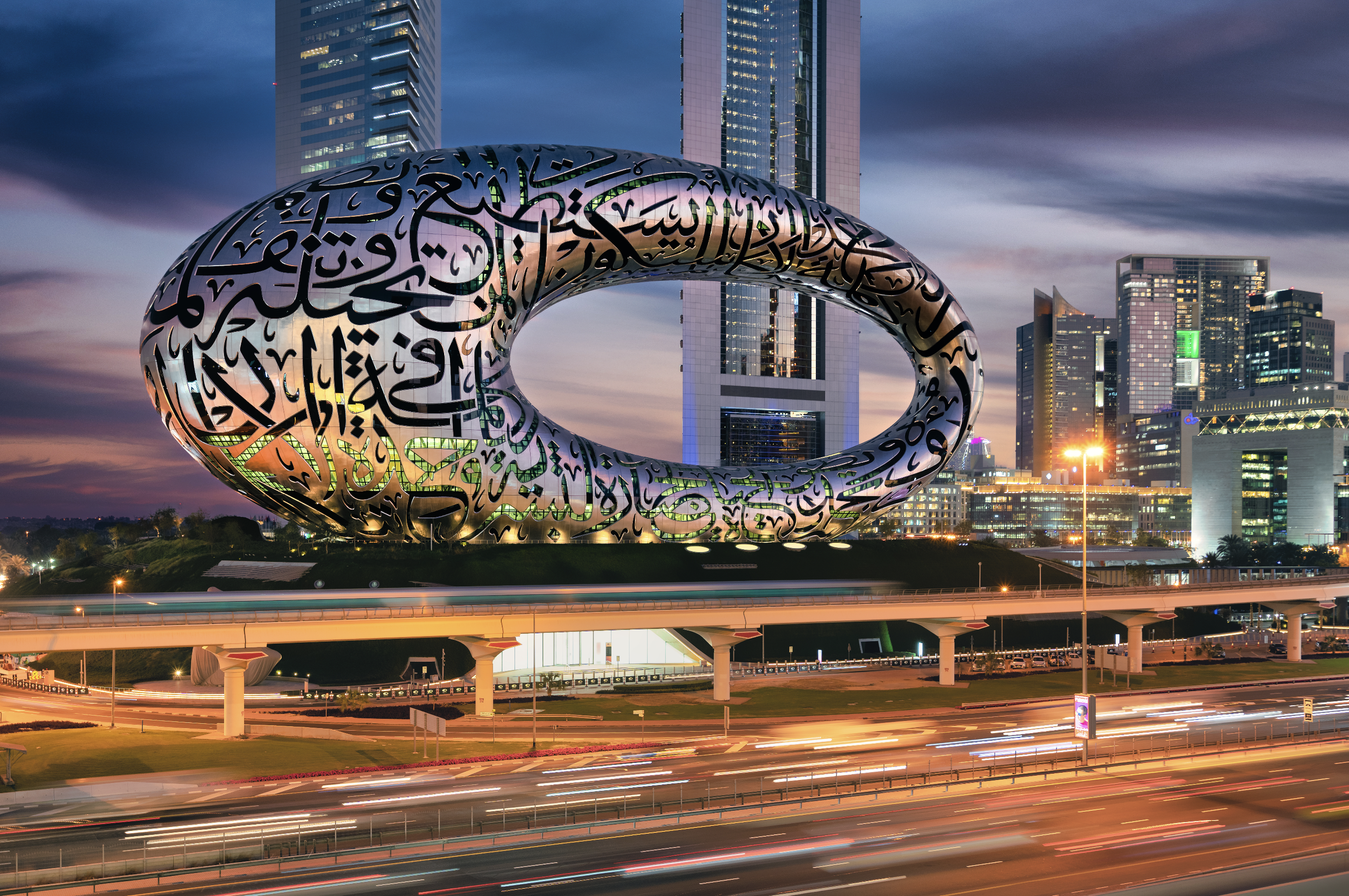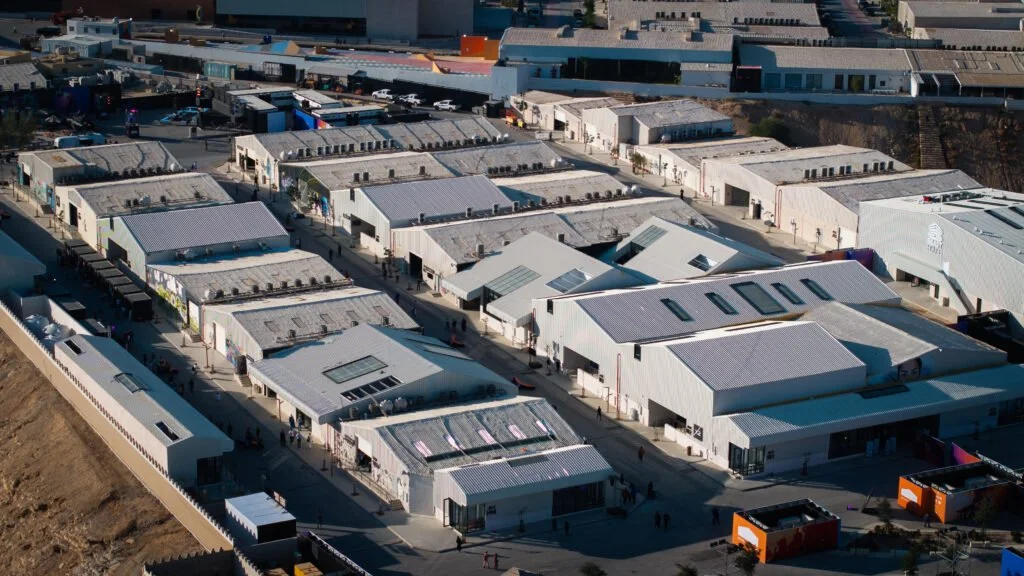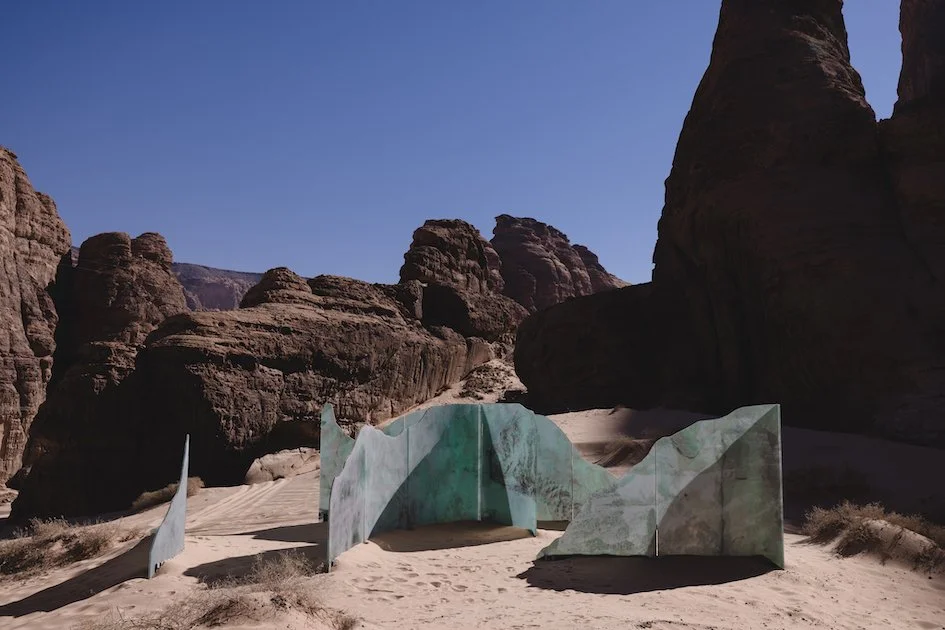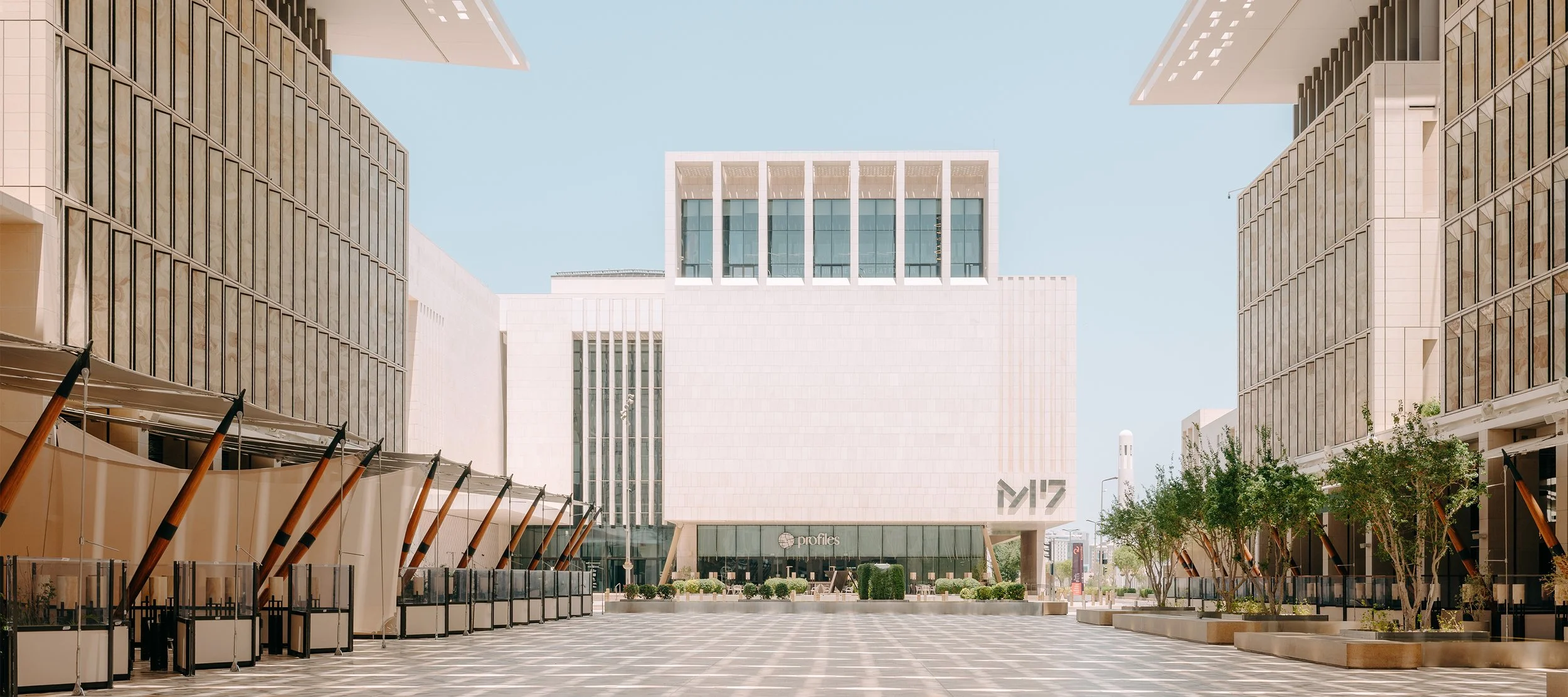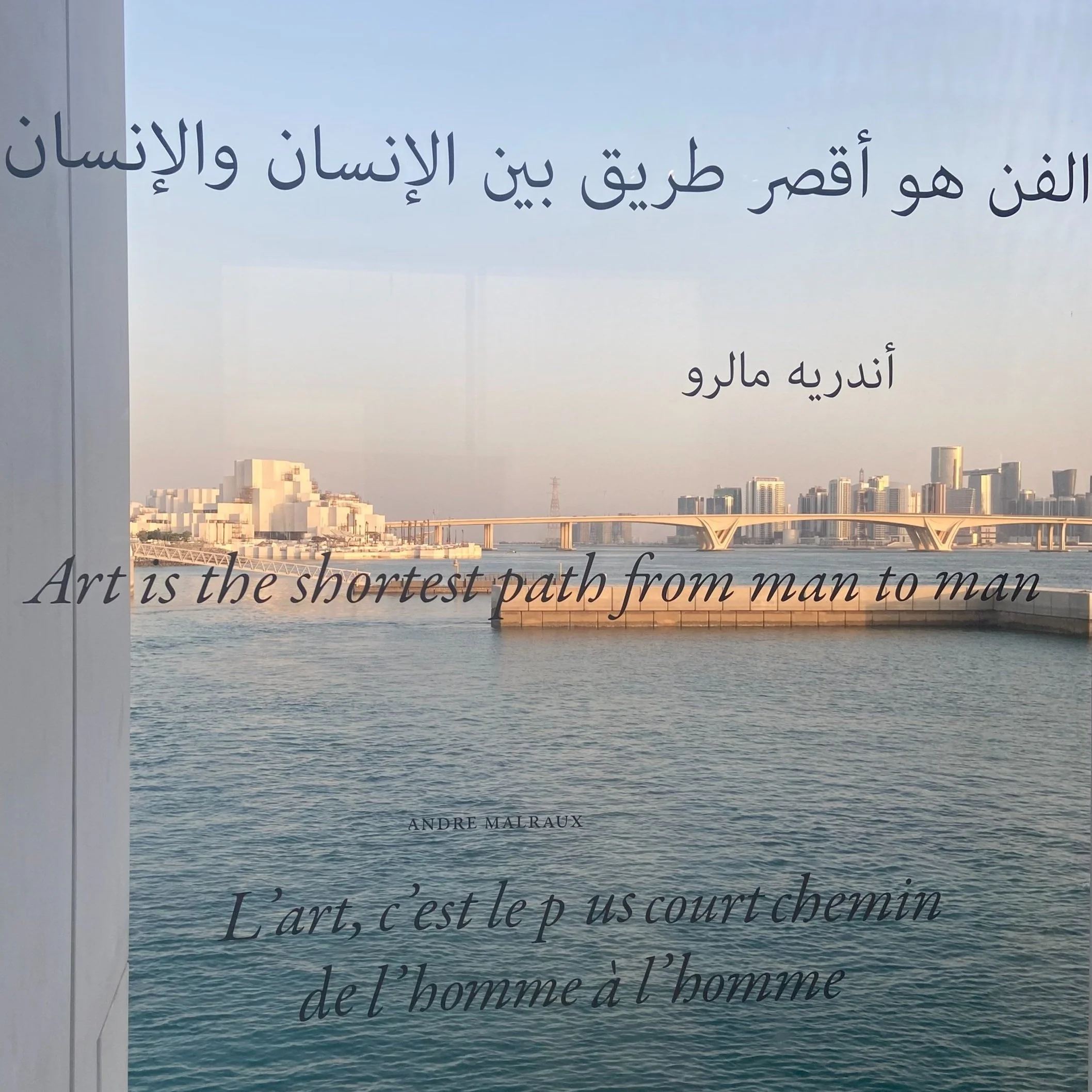The Rise of Art in the Middle East
From the sea © Louvre Abu Dhabi - Photography Roland Halbe
Abu Dhabi: A Cultural Powerhouse
In the shimmering waters of the Persian Gulf, just off the coast of Abu Dhabi, lies a cultural vision brought to life, Saadiyat Island. Often described as the UAE’s “Island of Enlightenment,” Saadiyat is more than just a man-made landmass. It is a bold statement of intent, Abu Dhabi’s declaration that art, culture, and dialogue are central to its identity and future. Saadiyat Island is not without its complexities, and its story is still being written. Yet, in less than two decades, it has transformed from a vision on a masterplan to a tangible reality that rivals some of the most storied art districts in the world. In doing so, it has reshaped perceptions—not only of Abu Dhabi, but of the Arab world’s place in the global cultural conversation.
In many ways, Saadiyat Island represents the future of art patronage: international in scope, inclusive in narrative, and bold in ambition. It is a beacon, not just of architectural splendor, but of a deeper, more enduring commitment to culture as a cornerstone of progress. For Abu Dhabi, it’s not just about building museums. It’s about building meaning.
View overlooking the sea © Louvre Abu Dhabi, Photography: Mohamed Somji
The Louvre Abu Dhabi: A Universal Museum for the Region
Perhaps the crown jewel of Saadiyat is the Louvre Abu Dhabi, the result of a groundbreaking cultural partnership between the UAE and France. Designed by Jean Nouvel, the museum opened in 2017 under a silvery dome that filters light like palm fronds, an architectural marvel echoing both Arabic and Mediterranean sensibilities. But more than its form, it is the content of the Louvre Abu Dhabi that sets it apart.
Unlike traditional museums segmented by region or period, the Louvre Abu Dhabi curates art through a universal lens, placing Chinese ceramics beside Islamic manuscripts, African masks alongside European oil paintings. This narrative of shared humanity is especially resonant in a globalized world, positioning Abu Dhabi as a convener of cross-cultural dialogue.
Courtesy of Guggenheim Museum
Guggenheim Abu Dhabi: A Monument to Modernity
Still under construction but no less influential, the Guggenheim Abu Dhabi promises to be one of the world’s largest and most comprehensive museums of contemporary art. Designed by Frank Gehry, the structure is a swirling composition of industrial materials and organic shapes, symbolizing the ever-evolving nature of contemporary art itself.
What sets the Guggenheim Abu Dhabi apart is its commitment to expanding the canon. It aims to place Middle Eastern, South Asian, and North African artists into global conversations that have too often centered on Western narratives. In doing so, it will offer a platform for voices and movements that have shaped, and continue to shape, the modern world.
Courtesy of Manarat Al Saadiyat
Manarat Al Saadiyat & Cultural Foundations
Beyond the blockbuster institutions, Manarat Al Saadiyat, which translates to “the place of enlightenment”, serves as the island’s cultural pulse. This multipurpose space hosts exhibitions, workshops, talks, and art fairs, acting as an incubator for local and regional talent. It’s where art meets community, and where cultural curiosity becomes cultural literacy.
The Abu Dhabi Art Fair, held annually on Saadiyat, has also grown into a vital meeting point for collectors, galleries, and artists from around the world. With its growing reputation, the fair not only celebrates Emirati talent but also connects it to broader regional and international markets.
Courtesy of Zayed National Museum
Education and Legacy
Integral to Saadiyat’s cultural blueprint is education. Institutions like NYU Abu Dhabi, located nearby, contribute to a knowledge-based ecosystem where art is not only displayed but discussed, critiqued, and studied. Programs foster partnerships between academia, artists, and institutions, ensuring that Saadiyat is not just a destination, but a living laboratory for ideas.
Moreover, The Zayed National Museum, set to open in the coming years, will add yet another layer by chronicling the history and legacy of the UAE’s founding father, Sheikh Zayed bin Sultan Al Nahyan, placing national heritage within a wider global context.
Dubai: Fusion of Innovation and Tradition
Once synonymous with architectural marvels and luxury, Dubai has emerged as a formidable force in the global art scene. At the heart of this transformation are three pivotal institutions: Art Dubai, Alserkal Avenue, and the Museum of the Future. Together, they encapsulate the city's commitment to fostering creativity, innovation, and cultural dialogue. The synergy between Art Dubai, Alserkal Avenue, and the Museum of the Future illustrates Dubai's holistic approach to cultural development. By intertwining traditional art forms with futuristic visions, the city offers a multifaceted cultural experience that resonates on a global scale.
As Dubai continues to invest in its cultural infrastructure and support for the arts, it not only enhances its own creative landscape but also contributes significantly to the global dialogue on art, innovation, and the future.
I'm Sorry, Adel Abidin (2008) | Presented at Art Dubai 2025 by Meem Gallery
Art Dubai 2025: A Global Confluence of Creativity
Celebrating its 20th edition, Art Dubai 2025 reaffirmed its status as the Middle East’s premier art fair. Hosted at the opulent Madinat Jumeirah from April 18 to 20, the fair showcased over 120 galleries representing artists from 65 cities worldwide . This year's theme, “The Fair of Discoveries,” emphasized the exploration of emerging art scenes and narratives.
Key Highlights:
Diverse Artistic Mediums: The fair featured works ranging from textiles and prints to video installations and immersive experiences, reflecting the evolving nature of contemporary art.
Innovative Programming: Art Dubai 2025 introduced a series of performances and site-specific interventions, notably by Mexican artist Héctor Zamora, challenging traditional perceptions of space and audience engagement.
Educational Initiatives: The fair continued its commitment to nurturing future cultural leaders through scholarship programs and professional development workshops.
Art Dubai's expansive reach and inclusive programming have solidified its role as a catalyst for cultural exchange and artistic innovation in the region.
Courtesy of Alserkal Avenue
Alserkal Avenue: Dubai’s Creative Nexus
Nestled in the industrial district of Al Quoz, Alserkal Avenue has transformed into a vibrant arts hub, housing over 70 creative spaces, including contemporary art galleries, performance venues, and design studios.
Notable Features:
Community Engagement: Initiatives like Quoz Arts Fest and Alserkal Lates foster community participation, offering workshops, performances, and open studio sessions that make art accessible to a broader audience.
Support for Emerging Artists: Alserkal Avenue provides residencies and exhibition opportunities for up-and-coming artists, emphasizing the development of local talent and the promotion of regional narratives.
Diverse Programming: The avenue hosts a range of events, from digital art festivals to traditional exhibitions, reflecting Dubai's multicultural fabric and its embrace of both heritage and innovation.
Alserkal Avenue stands as a testament to Dubai's dedication to cultivating a dynamic and inclusive art ecosystem.
Courtesy of MOTF
Museum of the Future: A Visionary Leap Forward
Dominating Dubai's skyline with its torus-shaped structure adorned with Arabic calligraphy, the Museum of the Future is more than an architectural marvel; it's a beacon of innovation and foresight.
Exhibition Highlights:
OSS Hope: An immersive experience simulating life aboard a space station, exploring humanity's potential future in space
The HEAL Institute: A digital recreation of the Amazon rainforest, emphasizing biodiversity and ecological preservation.
Al Waha: A sanctuary promoting wellness and mindfulness, encouraging visitors to reconnect with their senses in a technology-saturated world.
The museum's interactive exhibits and forward-thinking narratives position it as a hub for exploring the possibilities of tomorrow, today.
Saudi Arabia: Cultural Renaissance
Saudi Arabia is rapidly emerging as a pivotal player in the global art scene, with transformative initiatives that blend contemporary creativity with rich cultural heritage. Central to this evolution are the Diriyah Contemporary Art Biennale 2026, the dynamic JAX District in Riyadh, and the forthcoming Desert X AlUla 2026. Saudi Arabia is not only preserving its rich cultural heritage but also positioning itself at the forefront of contemporary artistic expression, fostering a dynamic and inclusive art ecosystem that resonates on a global scale.
Islamic Arts Biennale 2025, Photo by Marco Cappelletti, courtesy of the Diriyah Biennale Foundation
Diriyah Contemporary Art Biennale 2026: A Global Artistic Confluence
Scheduled from January to April 2026, the third edition of the Diriyah Contemporary Art Biennale will be curated by Nora Razian and Sabih Ahmed. The biennale aims to explore contemporary art's role amidst Saudi Arabia's rapid social transformation. Building upon the success of previous editions, which attracted over 340,000 visitors, this iteration promises to foster dialogue between local and international artists, curators, and audiences .
Image Courtesy of JAX District
JAX District: Riyadh's Creative Heartbeat
Once an industrial zone, the JAX District in Diriyah has been transformed into a vibrant cultural hub, housing artist studios, galleries, and event spaces. In April 2025, it hosted the inaugural Art Week Riyadh, organized by the Saudi Visual Arts Commission. The event featured curated exhibitions from over 30 local, regional, and international galleries, emphasizing the city's growing role in the global art landscape .
NEUMA – The Forgotten Ceremony by Sarah Brahim and Ugo Schiavi – AlUla Arts Festival. Image courtesy Royal Commission for AlUla
Desert X AlUla 2026: Art Amidst Ancient Landscapes
Following its previous editions, Desert X AlUla is set to return in 2026, continuing its tradition of site-specific installations amidst the stunning desert landscapes of AlUla. The 2024 edition, themed "In the Presence of Absence," featured works by artists like Giuseppe Penone and Kimsooja, exploring themes of the unseen and the inexpressible . The upcoming 2026 exhibition is anticipated to further this dialogue between art and nature, solidifying AlUla's position as a global destination for monumental land art.
M7 in Doha, Qatar | Image Courtesy of Art Basel
Qatar: A New Frontier in the Art World
In a landmark move that underscores Qatar's burgeoning role in the global art scene, Art Basel has announced the launch of its first Middle Eastern fair, set to debut in Doha in February 2026. This expansion marks a significant milestone for both Art Basel and the region, introducing a new platform for modern and contemporary art in the heart of the Middle East.
Art Basel Qatar is the result of a dynamic partnership between Art Basel's parent company, MCH Group, Qatar Sports Investments (QSI), and QC+, the commercial arm of Qatar Museums. This collaboration aims to create a premier event that not only showcases leading galleries and artists but also fosters year-round engagement with the arts in Qatar and the broader MENA region.
The inaugural fair will be hosted at M7, a cutting-edge creative hub located in Doha's Msheireb district. M7 is situated amidst a vibrant cultural landscape, neighboring landmarks such as the National Museum of Qatar. The fair is envisioned as a tightly curated showcase, highlighting the rich artistic diversity of the Middle East, North Africa, South Asia, and beyond.
Under the stewardship of Her Excellency Sheikha Al Mayassa bint Hamad bin Khalifa Al Thani, Chairperson of Qatar Museums, the country has made significant investments in cultural infrastructure over the past two decades. These efforts include the development of institutions like the Art Mill Museum and the Lusail Museum, as well as the establishment of a permanent Qatar Pavilion at the Venice Biennale. Art Basel Qatar builds upon this momentum, aiming to further integrate Qatar into the global art community.
The introduction of Art Basel Qatar is poised to reshape the global art calendar, particularly the February fair circuit. By establishing a presence in Doha, Art Basel not only taps into a region with a rich cultural heritage but also responds to a growing demand for platforms that highlight diverse artistic voices. This move signifies a broader shift towards inclusivity and globalization in the art market.
As preparations for the 2026 debut continue, Art Basel Qatar represents a significant step in Qatar's cultural evolution, offering new opportunities for artists, collectors, and art enthusiasts worldwide.
A LA ART’s Perspective
At A LA ART, we recognize the Middle East’s pivotal role in shaping the future of art.
From Abu Dhabi to Doha, a new art geography is emerging, intentional, interconnected, and unapologetically regional. The Gulf is no longer watching the global art world; it’s reshaping it. Abu Dhabi anchors this shift with Saadiyat Island, where world-class institutions like the Louvre Abu Dhabi and the upcoming Guggenheim forge a deep dialogue between heritage and modernity. Dubai thrives as a cosmopolitan lab, from the boundary-pushing installations of Art Dubai 2025 to the creative pulse of Alserkal Avenue and the forward-thinking ethos of the Museum of the Future.
Riyadh asserts its voice through the Diriyah Contemporary Art Biennale, JAX District’s dynamic programming, Art Week Riyadh and Desert X AlUla.
And Doha rises with the historic announcement of Art Basel Qatar, marking the first Middle Eastern edition of the world’s most influential art fair. Launching February 2026, it will position the city as a global magnet for art professionals, collectors and enthusiasts.
We see this moment not as a trend, but a turning point. The Gulf is not a backdrop, it’s becoming the stage. We are committed to guiding artists, collectors, and everyone in between through this evolving landscape, offering curated services that align with the region’s dynamic growth. Say hello and we’d be thrilled to connect!
